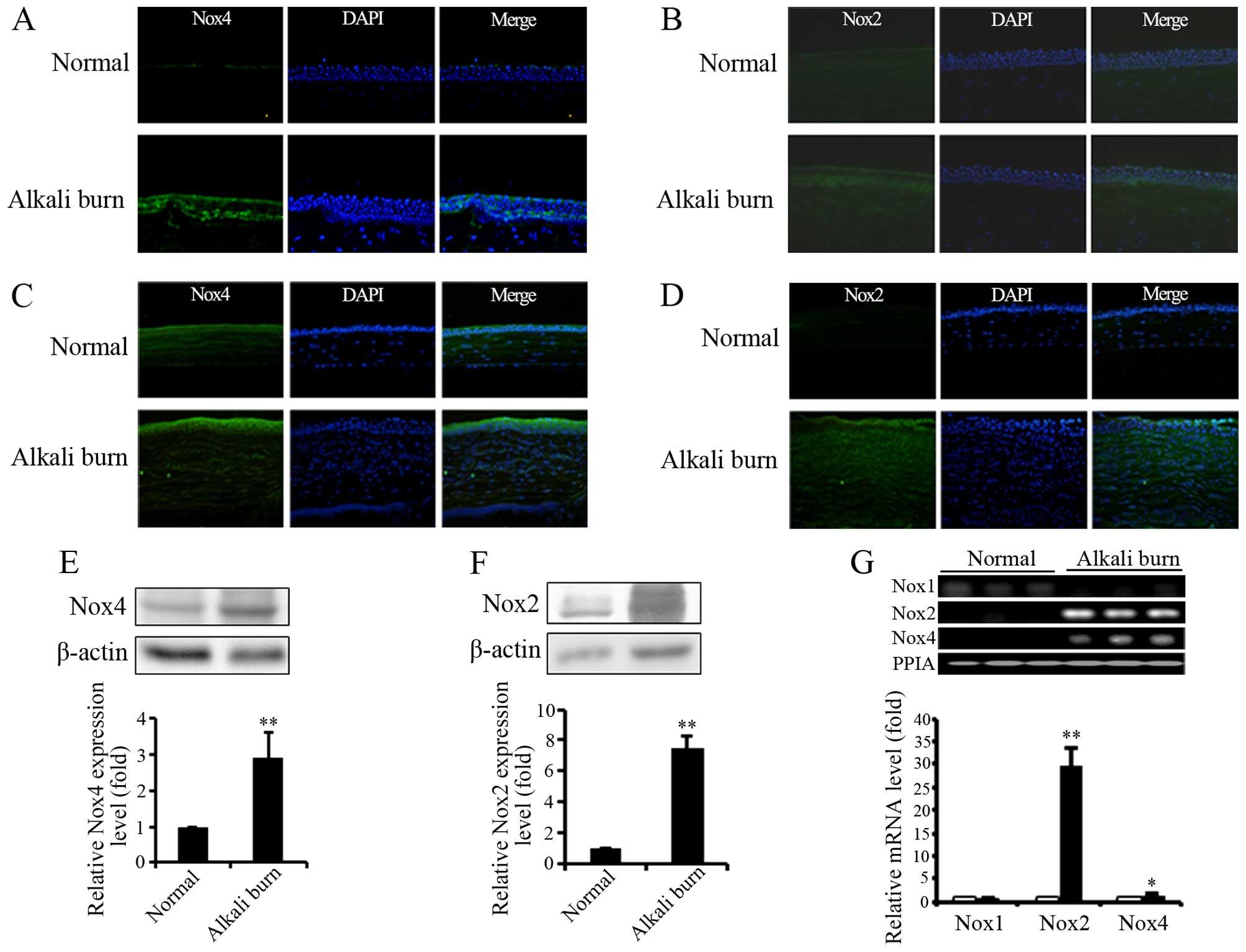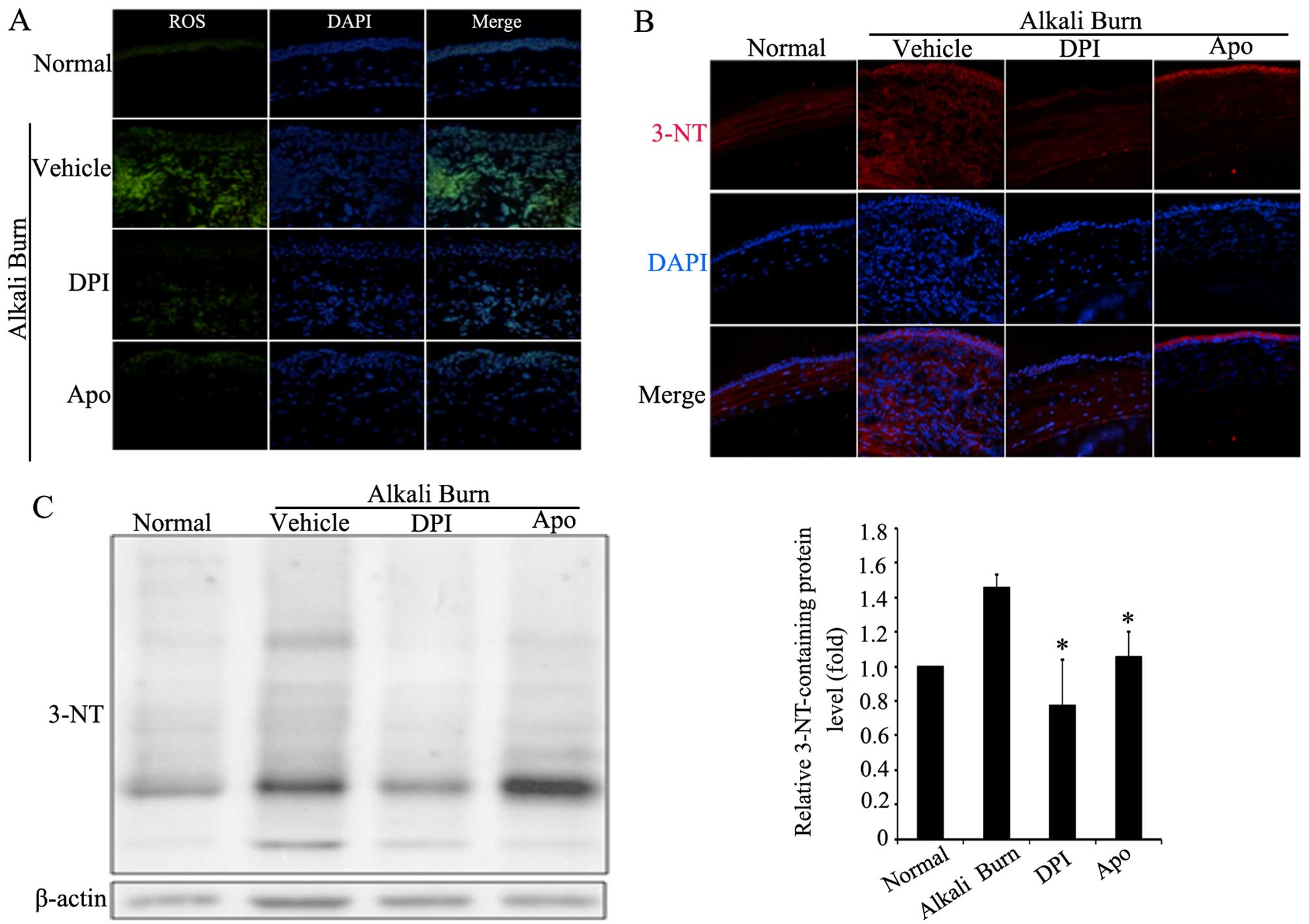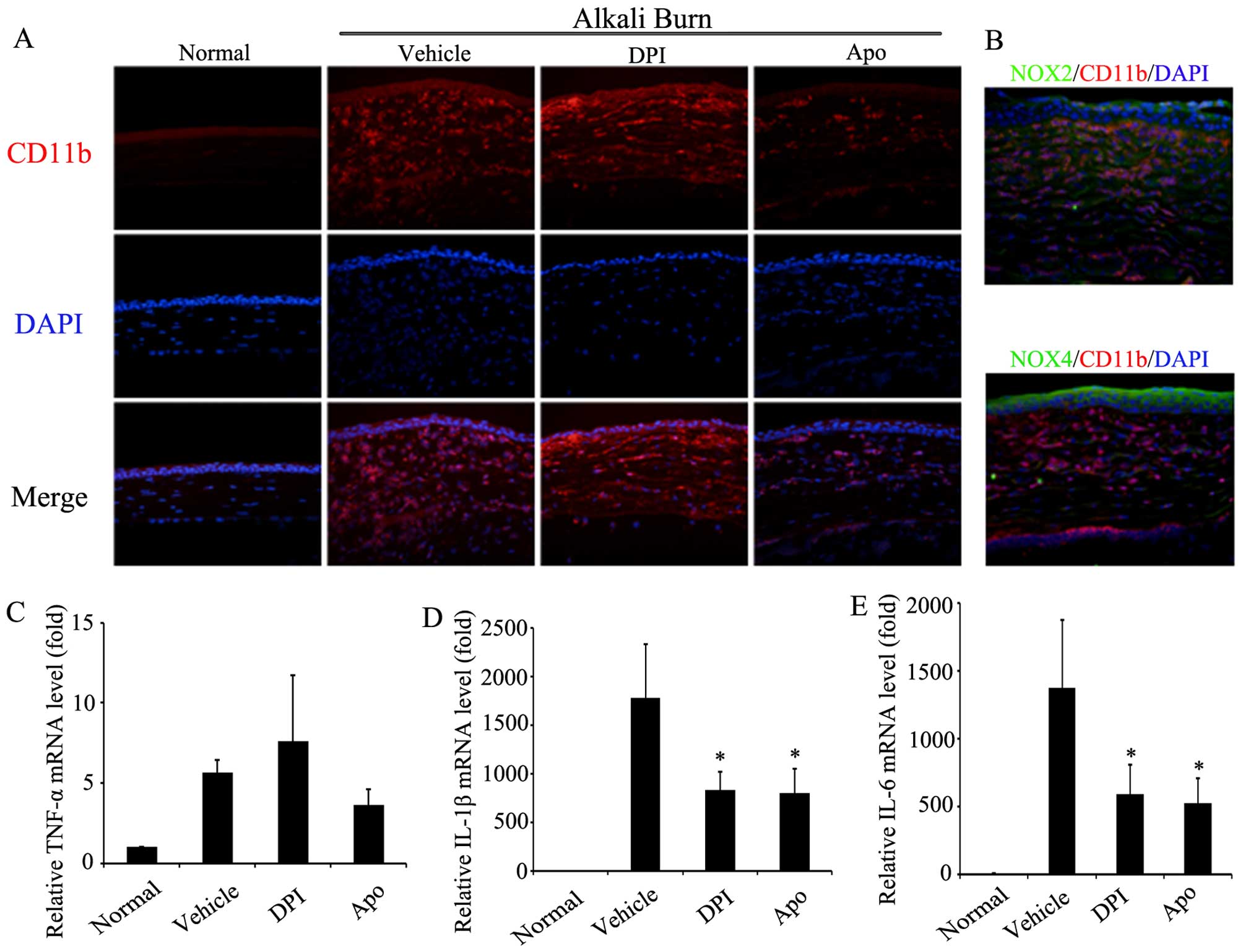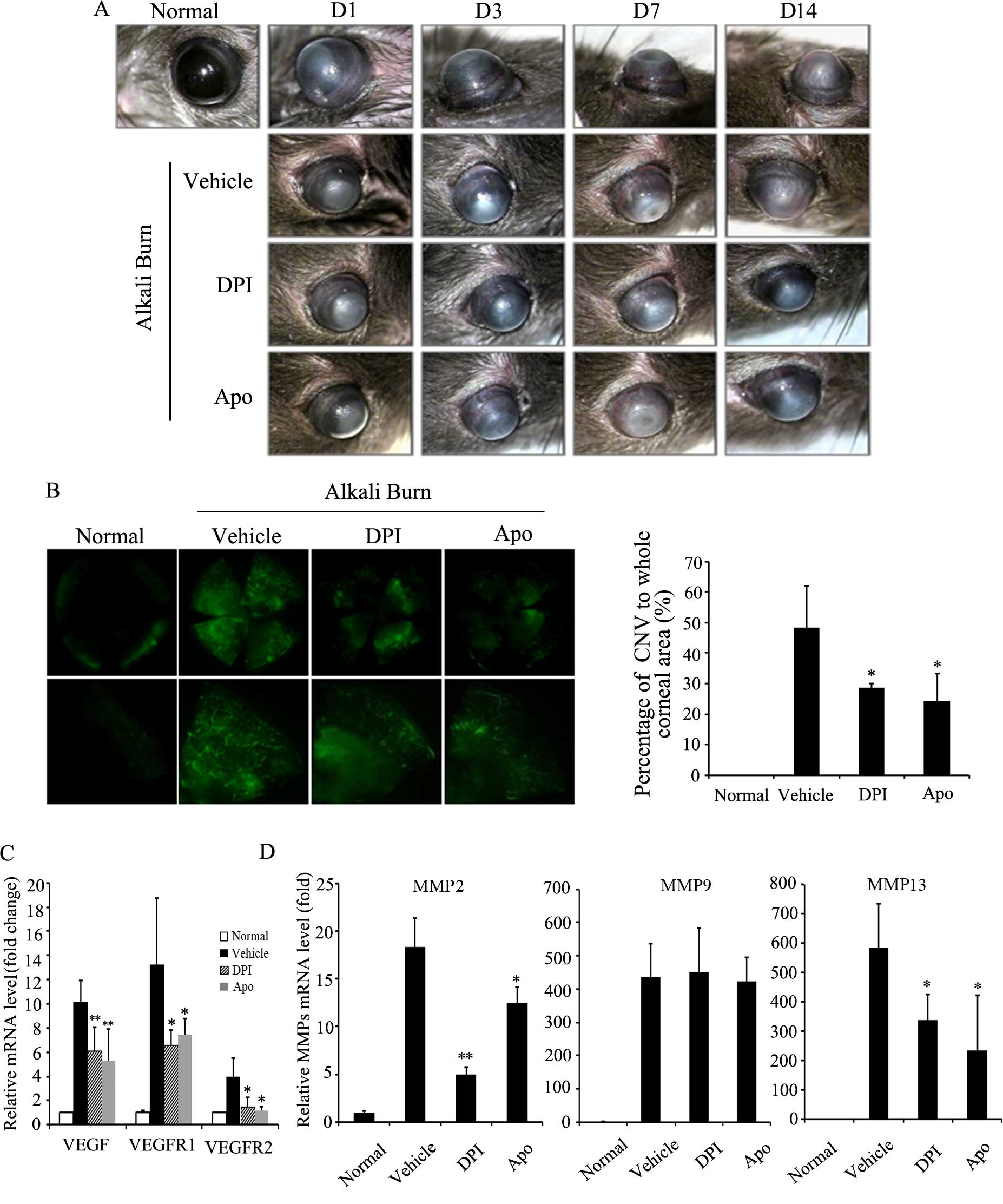|
1
|
Wagoner MD: Chemical injuries of the eye:
current concepts in pathophysiology and therapy. Surv Ophthalmol.
41:275–313. 1997. View Article : Google Scholar : PubMed/NCBI
|
|
2
|
Kubota M, Shimmura S, Kubota S, Miyashita
H, Kato N, Noda K, Ozawa Y, Usui T, Ishida S, Umezawa K, et al:
Hydrogen and N-acetyl-L-cysteine rescue oxidative stress-induced
angiogenesis in a mouse corneal alkali-burn model. Invest
Ophthalmol Vis Sci. 52:427–433. 2011. View Article : Google Scholar
|
|
3
|
Conners MS, Urbano F, Vafeas C, Stoltz RA,
Dunn MW and Schwartzman ML: Alkali burn-induced synthesis of
inflammatory eicosanoids in rabbit corneal epithelium. Invest
Ophthalmol Vis Sci. 38:1963–1971. 1997.PubMed/NCBI
|
|
4
|
Finkel T: Oxidant signals and oxidative
stress. Curr Opin Cell Biol. 15:247–254. 2003. View Article : Google Scholar : PubMed/NCBI
|
|
5
|
Mokini Z, Marcovecchio ML and Chiarelli F:
Molecular pathology of oxidative stress in diabetic angiopathy:
role of mitochondrial and cellular pathways. Diabetes Res Clin
Pract. 87:313–321. 2010. View Article : Google Scholar
|
|
6
|
Hakim FA and Pflueger A: Role of oxidative
stress in diabetic kidney disease. Med Sci Monit. 16:RA37–RA48.
2010.PubMed/NCBI
|
|
7
|
Blasiak J, Petrovski G, Veréb Z, Facskó A
and Kaarniranta K: Oxidative stress, hypoxia, and autophagy in the
neovascular processes of age-related macular degeneration. BioMed
Res Int. 2014:7680262014. View Article : Google Scholar : PubMed/NCBI
|
|
8
|
Shoham A, Hadziahmetovic M, Dunaief JL,
Mydlarski MB and Schipper HM: Oxidative stress in diseases of the
human cornea. Free Radic Biol Med. 45:1047–1055. 2008. View Article : Google Scholar : PubMed/NCBI
|
|
9
|
Saika S, Miyamoto T, Yamanaka O, Kato T,
Ohnishi Y, Flanders KC, Ikeda K, Nakajima Y, Kao WW, Sato M, et al:
Therapeutic effect of topical administration of SN50, an inhibitor
of nuclear factor-kappaB, in treatment of corneal alkali burns in
mice. Am J Pathol. 166:1393–1403. 2005. View Article : Google Scholar : PubMed/NCBI
|
|
10
|
Zhou AY, Bai YJ, Zhao M, Yu WZ and Li XX:
KH902, a recombinant human VEGF receptor fusion protein, reduced
the level of placental growth factor in alkali burn induced-corneal
neovascularization. Ophthalmic Res. 50:180–186. 2013. View Article : Google Scholar : PubMed/NCBI
|
|
11
|
Carter RT, Kambampati R, Murphy CJ and
Bentley E: Expression of matrix metalloproteinase 2 and 9 in
experimentally wounded canine corneas and spontaneous chronic
corneal epithelial defects. Cornea. 26:1213–1219. 2007. View Article : Google Scholar : PubMed/NCBI
|
|
12
|
Sumimoto H, Miyano K and Takeya R:
Molecular composition and regulation of the Nox family NAD(P)H
oxidases. Biochem Biophys Res Commun. 338:677–686. 2005. View Article : Google Scholar : PubMed/NCBI
|
|
13
|
Bedard K and Krause KH: The NOX family of
ROS-generating NADPH oxidases: physiology and pathophysiology.
Physiol Rev. 87:245–313. 2007. View Article : Google Scholar : PubMed/NCBI
|
|
14
|
Sareila O, Kelkka T, Pizzolla A, Hultqvist
M and Holmdahl R: NOX2 complex-derived ROS as immune regulators.
Antioxid Redox Signal. 15:2197–2208. 2011. View Article : Google Scholar
|
|
15
|
Nisimoto Y, Diebold BA, Cosentino-Gomes D
and Lambeth JD: Nox4: a hydrogen peroxide-generating oxygen sensor.
Biochemistry. 53:5111–5120. 2014. View Article : Google Scholar : PubMed/NCBI
|
|
16
|
Geiszt M, Kopp JB, Várnai P and Leto TL:
Identification of renox, an NAD(P)H oxidase in kidney. Proc Natl
Acad Sci USA. 97:8010–8014. 2000. View Article : Google Scholar : PubMed/NCBI
|
|
17
|
Hilenski LL, Clempus RE, Quinn MT, Lambeth
JD and Griendling KK: Distinct subcellular localizations of Nox1
and Nox4 in vascular smooth muscle cells. Arterioscler Thromb Vasc
Biol. 24:677–683. 2004. View Article : Google Scholar
|
|
18
|
Kuroda J, Nakagawa K, Yamasaki T, Nakamura
K, Takeya R, Kuribayashi F, Imajoh-Ohmi S, Igarashi K, Shibata Y,
Sueishi K and Sumimoto H: The superoxide-producing NAD(P)H oxidase
Nox4 in the nucleus of human vascular endothelial cells. Genes
Cells. 10:1139–1151. 2005. View Article : Google Scholar : PubMed/NCBI
|
|
19
|
Ellis EA, Grant MB, Murray FT, Wachowski
MB, Guberski DL, Kubilis PS and Lutty GA: Increased NADH oxidase
activity in the retina of the BBZ/Wor diabetic rat. Free Radic Biol
Med. 24:111–120. 1998. View Article : Google Scholar : PubMed/NCBI
|
|
20
|
Petry A, Djordjevic T, Weitnauer M,
Kietzmann T, Hess J and Görlach A: NOX2 and NOX4 mediate
proliferative response in endothelial cells. Antioxid Redox Signal.
8:1473–1484. 2006. View Article : Google Scholar : PubMed/NCBI
|
|
21
|
Manea A, Tanase LI, Raicu M and Simionescu
M: Transcriptional regulation of NADPH oxidase isoforms, Nox1 and
Nox4, by nuclear factor-kappaB in human aortic smooth muscle cells.
Biochem Biophys Res Commun. 396:901–907. 2010. View Article : Google Scholar : PubMed/NCBI
|
|
22
|
Deem TL and Cook-Mills JM: Vascular cell
adhesion molecule 1 (VCAM-1) activation of endothelial cell matrix
metalloproteinases: role of reactive oxygen species. Blood.
104:2385–2393. 2004. View Article : Google Scholar : PubMed/NCBI
|
|
23
|
Li J, Wang JJ, Yu Q, Chen K, Mahadev K and
Zhang SX: Inhibition of reactive oxygen species by Lovastatin
down-regulates vascular endothelial growth factor expression and
ameliorates blood-retinal barrier breakdown in db/db mice: role of
NADPH oxidase 4. Diabetes. 59:1528–1538. 2010. View Article : Google Scholar : PubMed/NCBI
|
|
24
|
O'Brien WJ, Krema C, Heimann T and Zhao H:
Expression of NADPH oxidase in rabbit corneal epithelial and
stromal cells in culture. Invest Ophthalmol Vis Sci. 47:853–863.
2006. View Article : Google Scholar : PubMed/NCBI
|
|
25
|
O'Brien WJ, Heimann T and Rizvi F: NADPH
oxidase expression and production of superoxide by human corneal
stromal cells. Mol Vis. 15:2535–2543. 2009.PubMed/NCBI
|
|
26
|
Ren S, Zhang F, Li C, Jia C, Li S, Xi H,
Zhang H, Yang L and Wang Y: Selection of housekeeping genes for use
in quantitative reverse transcription PCR assays on the murine
cornea. Mol Vis. 16:1076–1086. 2010.PubMed/NCBI
|
|
27
|
Matthiesen S, Lindemann D, Warnken M,
Juergens UR and Racké K: Inhibition of NADPH oxidase by apocynin
inhibits lipopolysaccharide (LPS) induced up-regulation of arginase
in rat alveolar macrophages. Eur J Pharmacol. 579:403–410. 2008.
View Article : Google Scholar
|
|
28
|
Ahsan H: 3-Nitrotyrosine: A biomarker of
nitrogen free radical species modified proteins in systemic
autoimmunogenic conditions. Hum Immunol. 74:1392–1399. 2013.
View Article : Google Scholar : PubMed/NCBI
|
|
29
|
Benayoun Y, Casse G, Forte R, Dallaudière
B, Adenis JP and Robert PY: Corneal neovascularization:
epidemiological, physiopathological, and clinical features. J Fr
Ophtalmol. 36:627–639. 2013.In French. View Article : Google Scholar : PubMed/NCBI
|
|
30
|
Hamill CE, Bozorg S, Peggy Chang HY, Lee
H, Sayegh RR, Shukla AN and Chodosh J: Corneal alkali burns: a
review of the literature and proposed protocol for evaluation and
treatment. Int Ophthalmol Clin. 53:185–194. 2013. View Article : Google Scholar : PubMed/NCBI
|
|
31
|
Cejkova J, Trosan P, Cejka C, Lencova A,
Zajicova A, Javorkova E, Kubinova S, Sykova E and Holan V:
Suppression of alkali-induced oxidative injury in the cornea by
mesenchymal stem cells growing on nanofiber scaffolds and
transferred onto the damaged corneal surface. Exp Eye Res.
116:312–323. 2013. View Article : Google Scholar : PubMed/NCBI
|
|
32
|
Jiang F, Zhang Y and Dusting GJ: NADPH
oxidase-mediated redox signaling: roles in cellular stress
response, stress tolerance, and tissue repair. Pharmacol Rev.
63:218–242. 2011. View Article : Google Scholar : PubMed/NCBI
|
|
33
|
Sotozono C, He J, Matsumoto Y, Kita M,
Imanishi J and Kinoshita S: Cytokine expression in the
alkali-burned cornea. Curr Eye Res. 16:670–676. 1997. View Article : Google Scholar : PubMed/NCBI
|
|
34
|
Ushio-Fukai M: Redox signaling in
angiogenesis: role of NADPH oxidase. Cardiovasc Res. 71:226–235.
2006. View Article : Google Scholar : PubMed/NCBI
|
|
35
|
Shakiba Y, Mansouri K, Arshadi D and
Rezaei N: Corneal neovascularization: molecular events and
therapeutic options. Recent Pat Inflamm Allergy Drug Discov.
3:221–231. 2009. View Article : Google Scholar : PubMed/NCBI
|
|
36
|
Lassègue B and Griendling KK: NADPH
oxidases: functions and pathologies in the vasculature.
Arterioscler Thromb Vasc Biol. 30:653–661. 2010. View Article : Google Scholar :
|
|
37
|
Nayernia Z, Jaquet V and Krause KH: New
insights on NOX enzymes in the central nervous system. Antioxid
Redox Signal. 20:2815–2837. 2014. View Article : Google Scholar :
|
|
38
|
Kimura M, Rabbani ZN, Zodda AR, Yan H,
Jackson IL, Polascik TJ, Donatucci CF, Moul JW, Vujaskovic Z and
Koontz BF: Role of oxidative stress in a rat model of
radiation-induced erectile dysfunction. J Sex Med. 9:1535–1549.
2012. View Article : Google Scholar : PubMed/NCBI
|
|
39
|
Spencer NY and Engelhardt JF: The basic
biology of redoxosomes in cytokine-mediated signal transduction and
implications for disease-specific therapies. Biochemistry.
53:1551–1564. 2014. View Article : Google Scholar : PubMed/NCBI
|













